All Classes and Interfaces
Class
Description
Author processing utilities.
Utilities for working with books.
A caching cache, whether shared between requests or used within the scope of
a single request.
Constrains allowed exception type.
Resolves the cache to use for the current request.
The capture modes.
A component is able to render itself within the page.
The set of allowed component locations.
Utilities for working with components.
Determines if concurrent processing is recommended for the current request.
Copyright processing utilities.
Tracking of the current node during request processing and capturing.
Tracking of the current page during request processing and capturing.
The base for capturing elements.
Builds a tree, filtering for a specific element type.
A filter to select non-hidden and by element class.
A filter to select elements by arbitrary conditions.
Per-context executors for concurrent processing.
Provides static access to the client-provided headers.
HttpServletRequest, HttpServletResponse, and the response PrintWriter are frequently accessed
while also frequently updated by elements for capture.
Maintains current page context for the provided callable.
Convenience access to encoding to current PageContext through static import.
Maintains current page context for the provided runnable.
Also provides convenience access to all the PrintWriter methods, available through static import.
Utilities for working with directed acyclic graphs (DAGs) of pages.
Captures all pages recursively and builds an index of pages
for fast page number lookups.
Helper utilities for resolving PageRefs.
Automatically sets up the Page and the PageContext.
Utilities for working with pages.
Provides a simplified interface for obtaining localized values from the ApplicationResources.properties files.
The SemanticCMS application context.
Exposes the application context as an application-scope
SemanticCMS instance named
"SemanticCMS.APPLICATION_ATTRIBUTE_NAME".Resolves the link CSS class for the given types of elements.
Resolves the list item CSS class for the given types of nodes.
An ElementContext that is a ServletContext.
A theme is responsible for the overall view of the site.
A site may provide multiple views of the data.
View groupings, in order.
